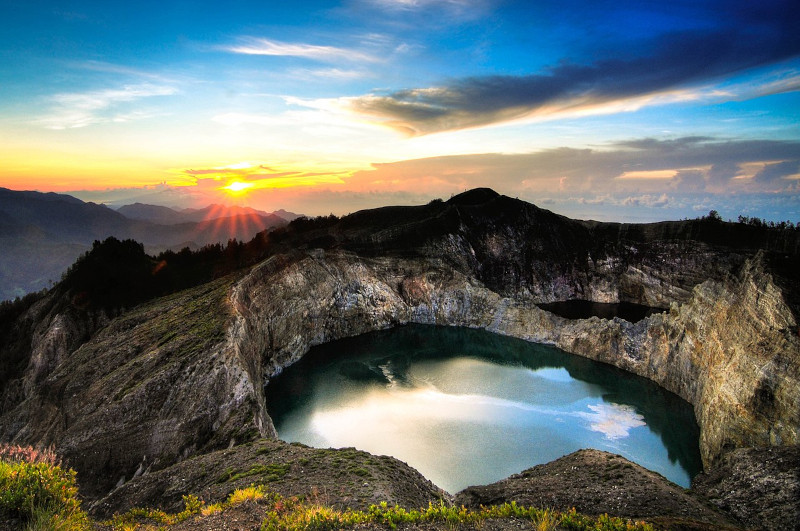Kelimutu Facts
- The incredible marvel of nature known simply as Kelimutu stands out from others of its kind as a truly remarkable volcano. This impressive geological feature further earns that unique distinction for a truly remarkable reason, the nature of which might surprise many.
- That’s because this captivating marvel of geology represents one of the few known volcanoes on earth to actually possess a total of 3 calderas. However, the simple fact that it possesses such an almost unheard of number of these isn’t the only reason for its fame.
- In point of fact, the magnificent site actually holds yet another startling secret. That’s because each of these separate depressions also contains a natural lake. But the wonders don’t end there. Each of these surprising lakes also contains different colored water.
- This astounding trio of lakes within Kelimutu only partially attain their colors as a result of the activities of the volcano itelf, though. The volcanic gases emitted by fumaroles in the crater of Kelimutu also interact with chemicals in the water of these amazing lakes.
- The colors of the bodies of water actually change from time to time as a result of random periodic alterations in their chemical composition. These also periodically change due to adjustments in the oxidation-reduction status of the fluid contained within each lake.
- Due to its remarkable distinctiveness, this marvel of geology earns a unique status. It represents both a national treasure and an important cultural landmark in its region. Accordingly, it forms the central feature of the Kelimutu National Park, established in 1992.
Related Articles
Kelimutu Physical Description
The truly mesmerizing beauty of Kelimutu certainly isn’t its only respectable statistic, however. The wonder of geology also boasts some other fully respectable characteristics worthy of a certain level of admiration. For one, it also resides at an altitude of roughly 5,377 ft (1,639 m) above sea level.
Incredibly, two of its three calderas actually have a shared wall, while the third sits a short distance to the west. Understandably, these aren’t uniform in nature. The walls of each individual feature also vary in height, with the highest prominence measuring approximately 157 ft (48 m).
The fully independent and somewhat isolated lake situated slightly to the west of the others typically displays either a dazzling blue or dark green shade. In the language of the region, it bears the name of Tiwu Ata Bupu. That translates into English as “Lake of Old People.”
All of these separate features formed at the summit. The two calderas that share a wall bear the somewhat tongue-twisting titles of Tiwu Ko’o Fai Nuwa Muri and Tiwu Ata Polo. Respectively, these designations literally mean Lake of Young Men and Maidens and Lake of Evil Spirits.
Tiwu Ko’o Fai Nuwa Muri generally varies in hue from turquoise to bright green. Tiwu Ata Polo, meanwhile, typically presents as dark green, brown, or even a brilliant red. In all instances, however, each of these changes almost continuously, due to variations in chemical reactions.
Kelimutu Location and Nature
The stunning masterpiece created by the forces of Nature that mankind calls Kelimutu lies in a somewhat remote portion of the world. More precisely, the volcano sits on an island bearing the name of Flores. This location lies in the section of the earth known as Indonesia, in Asia.
The summit of this volcano became highly elongated over time. This formative action occurred as a direct result of geological forces. Due to their slow but irresistible efforts, the site now has a roughly rectangular shape. Many small fumaroles also populate the floors of the separate calderas.
The powerful gases released by these numerous and widespread fumaroles also have their own direct bearing on the coloring of the waters. That’s because these fumes strongly interact with the various chemicals and minerals naturally inherent to each of the three individual lakes.
The staggering natural wonder sits alone in its area. Even today, the nearest populated area remains the town named Moni, by the locals. This residential area sits about 50 mi (80 km) away from the volcano. Despite its remoteness, however, it has become a popular tourist attraction.
This fascinating location also boasts an impressive degree of biodiversity. Its ecosystems consist of montane forests, sub-alpine vegetation, and volcanic landscapes. The area serves as home to a variety of plant and animal species, some of which remain solely endemic to the locale.
Among other features, its surroundings contain visually stunning forests. These contain a respectable variety of species, such as Casuarina trees, Ficus species, and Eucalyptus urophylla. Mosses and ferns additonally thrive in the relatively moist environment around the lakes.
Not to be outdone, fauna also abounds on and around Kelimutu. It’s home to numerous bird species, some of which continue to be quite rare. These avians include the distinctive Flores monarch and Flores scops owl, both of which are endemic and considered endangered.
The locale further houses mammalian species like the Timor deer, Leopard cat, and several species of bats, as well. The inhabitants of the area also include a broad-ranging variety of both unique insects and frogs adapted to the highly specific conditions of the volcanic environment.
Features Sharing Its Region
Check out our other articles on Pingualuit Crater Lake, Homestead Caldera, Fly Geyser, Lagoa do Fogo, Boiling Lake, 7 Spellbinding African Marvels, Blue-lipped sea krait, Weka

